|
FATEHPUR SIKRI
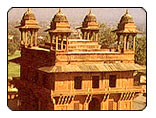 Between 1570 and 1585, during the reign of Emperor Akbar, the capital of the Mughal Empire was situated here, 40 km west of
Agra. Then, as suddenly and dramatically as this new city had been built,
it was abandoned, mainly due, it is thought, to difficulties with the
water supply. Today’s it’s a perfectly preserved example of a Mughal
city at the height of the empire’s splendour- an attraction no visitor
to Agra should miss. Between 1570 and 1585, during the reign of Emperor Akbar, the capital of the Mughal Empire was situated here, 40 km west of
Agra. Then, as suddenly and dramatically as this new city had been built,
it was abandoned, mainly due, it is thought, to difficulties with the
water supply. Today’s it’s a perfectly preserved example of a Mughal
city at the height of the empire’s splendour- an attraction no visitor
to Agra should miss.
Legend says that Akbar was without a male heir and made a
pilgrimage to this spot to see the saint Shaikh Salim Chishti. The saint
foretold the birth of Akbar’s son, the future emperor, Jehangir, and in
gratitude Akbar named his son Salim. Furthermore, Akbar transferred his
capital to Sikri and built a new and splendid city.
Although a Muslim, Akbar was known to be very tolerant towards
other religions, and he spent much time, discussing and studying them in
Fatehpur Sikri. He also developed a new religion called Deen Ilahi which
attempted to synthesise elements from all the major religions. Akbar’s
famous courtiers, such as Bibal, Raja Todarmal and Abu Fazal, had their
houses near his palace in the city.
Most people visit Fatehpur Sikri as a day trip from Agra, but it
can be a pleasant place to stay. Spending the night here would allow you
to watch the Impressive sunset over the ruins. The best place is from the
top of the city walls, a two-km walk to the south.
JAMA
MASJID (Dargah Mosque)
Fatehpur
Sikri’s mosque is said to be a copy of the mosque at Mecca, and is a
beautiful building containing elements of Persian and Hindu design.
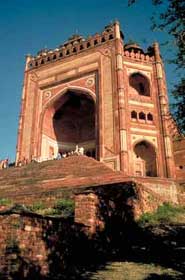 The main entrance is through the 54-
metre-high Buland Darwaza
the Gate of Victory, constructed to commemorate Akbar’s victory in Gujarat. This impressive gateways is reached by an equally Impressive
flight of steps. A Koranic inscription inside the archway includes the
useful thought: ‘The world is a bridge, pass over it but build no house
upon it. He who hopes for an hour may hope for eternity ‘.A large colony
of bees has established itself at this gateways but apart from raining
little yellow stains on passers-by below they seem to leave visitors
alone. Just outside the gateway is a deep well and, when there is a
sufficient number of tourists assembled, local daredevils leap from the
top of the entrance into the water. The main entrance is through the 54-
metre-high Buland Darwaza
the Gate of Victory, constructed to commemorate Akbar’s victory in Gujarat. This impressive gateways is reached by an equally Impressive
flight of steps. A Koranic inscription inside the archway includes the
useful thought: ‘The world is a bridge, pass over it but build no house
upon it. He who hopes for an hour may hope for eternity ‘.A large colony
of bees has established itself at this gateways but apart from raining
little yellow stains on passers-by below they seem to leave visitors
alone. Just outside the gateway is a deep well and, when there is a
sufficient number of tourists assembled, local daredevils leap from the
top of the entrance into the water.
The eastern gate of the mosque is known as the Shahi Darwaza
(King’s Gate), and was the one formerly used by Akbar.
Palace of Jodh Bai
North-east
of the mosque is the ticket office and entrance to
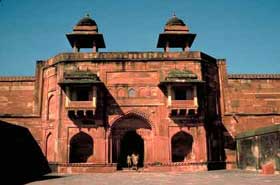 the old city. The first
building inside the gate is a palace, commonly but wrongly ascribed to Jodh Bai, Jehangir’s Hindu mother and the daughter of the maharaja of
Amber. the old city. The first
building inside the gate is a palace, commonly but wrongly ascribed to Jodh Bai, Jehangir’s Hindu mother and the daughter of the maharaja of
Amber.
The architecture is a blend of styles with Hindu columns and
Muslims cupolas. The Hawa Mahal (Palace of the Winds) is a
projecting room whose walls are made entirely of stone latticework. The
ladies of the court may have sat inside to keep an unobtrusive eye on
events below.
Birbal Bhavan
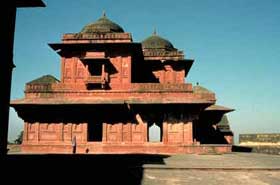 Thought
to have been built either by or for Akbar’s favourite courtier, Raja
Birbal building provoked Victor Hugo, this elegant building provoked
Victor Hugo, the 19th century French author, to comment that it
was either a very small palace or a very large jewellery box. Birbal, who
was a Hindu and noted for his wit and wisdom, unfortunately proved to be a
hopeless soldier and lost his life, and most of his army, near Peshwar in
1586. The palace fronts onto the Lower Haramsara, which was once
believed to be an enormous stable, with nearly 200 enclosures for
elephants, horses and camels. This is now thought to be where the palace,
maids lived. The stone rings still in evidence were more likely to have
been used to secure curtains than to fetter pachyderms. Thought
to have been built either by or for Akbar’s favourite courtier, Raja
Birbal building provoked Victor Hugo, this elegant building provoked
Victor Hugo, the 19th century French author, to comment that it
was either a very small palace or a very large jewellery box. Birbal, who
was a Hindu and noted for his wit and wisdom, unfortunately proved to be a
hopeless soldier and lost his life, and most of his army, near Peshwar in
1586. The palace fronts onto the Lower Haramsara, which was once
believed to be an enormous stable, with nearly 200 enclosures for
elephants, horses and camels. This is now thought to be where the palace,
maids lived. The stone rings still in evidence were more likely to have
been used to secure curtains than to fetter pachyderms.
Karawan Serai & Hiran Minar
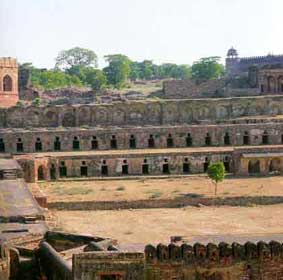 The
Karawan Serai or Caravanserai was a large courtyard surrounded by the
hostels used by visiting merchants. Outside the fort grounds. The Hiran
Minar (Deer Minaret) is said to have been erected over the grave of
Akbar’s favourite elephants.
Stone elephants tusks protude form the 21m tower from which Akbar is said
to have shot at deer and other game which were driven in front of him. The
flat expanse of land stretching away from the tower was once a lake and
still occasionally floods today.
The
Karawan Serai or Caravanserai was a large courtyard surrounded by the
hostels used by visiting merchants. Outside the fort grounds. The Hiran
Minar (Deer Minaret) is said to have been erected over the grave of
Akbar’s favourite elephants.
Stone elephants tusks protude form the 21m tower from which Akbar is said
to have shot at deer and other game which were driven in front of him. The
flat expanse of land stretching away from the tower was once a lake and
still occasionally floods today.
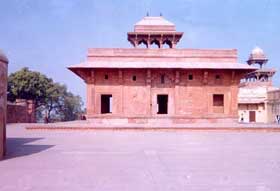
Palace of the Christian Wife
Close
to the Jodh Bai Palace, this house was used by Akbar’s Goan Christian
wife, Maryam, and at one time was gilded throughout –giving it the name
the Golden House.
Panch Mahal
This
whimsical five storey palace was probably once used by
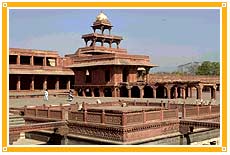 the ladies of the
court and originally had stone screens on the sides. These have now been
removed, making the open colonnades inside visible. Like a house of cards,
each of the five storeys is stepped back from the previous one until the
top floor consists of only a tiny kiosk. the ladies of the
court and originally had stone screens on the sides. These have now been
removed, making the open colonnades inside visible. Like a house of cards,
each of the five storeys is stepped back from the previous one until the
top floor consists of only a tiny kiosk.
Diwan-I-Khas
The Hall of Private
Audiences, known as the Jewel House, is
 unique
for its interior design. A carved stone column in the center of the
building flares to support a flat-topped ‘throne’ which is 6m high. Narrow stone bridges radiate
from the corners of the room and meet at the throne. The function of the
building is disputed; some think Akbar spent
much time on the ‘throne’ discussing and debating with scholars
of different religious persuasions; others believe it to be the perch from
which he meted out justice. Another possibility is that this was where the
emperor was weighed at the commencement of the Persian New Year. unique
for its interior design. A carved stone column in the center of the
building flares to support a flat-topped ‘throne’ which is 6m high. Narrow stone bridges radiate
from the corners of the room and meet at the throne. The function of the
building is disputed; some think Akbar spent
much time on the ‘throne’ discussing and debating with scholars
of different religious persuasions; others believe it to be the perch from
which he meted out justice. Another possibility is that this was where the
emperor was weighed at the commencement of the Persian New Year.
Diwan –I- Am
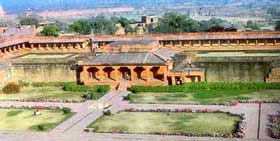 Just inside the
north-eastern gates of the deserted city is the Hall of Public Audiences,
a large open courtyard surrounded by cloisters. Beside the Diwan-I-Am is
the Pachisi Coutyard, set out like a gigantic game board. It is
said that Akbar played the game pachisi here, using slave girls as the
pieces.
Just inside the
north-eastern gates of the deserted city is the Hall of Public Audiences,
a large open courtyard surrounded by cloisters. Beside the Diwan-I-Am is
the Pachisi Coutyard, set out like a gigantic game board. It is
said that Akbar played the game pachisi here, using slave girls as the
pieces.
Other Monuments
Musicians would play
from the Naubat Khana, at one time the main entrance to the city,
as processions passed beneath. The entrance road then ran between the mint
and the treasury before reaching the Diwan-I-Am. The Diwan Khana-I-
Khas (Khwabgah), in front of the Daftar
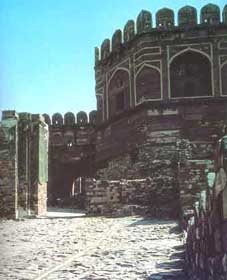 Khana (Record office), was
Akbar’s own sleeping quarters. Beside the Khawabgah is the tiny but
elaborately carved Rumi Sultana or Turkish Queen’s House. Near
the Karawan Serai, badly defaced elephants still guard the Hathi Pol,
or
Elephant Gate. Khana (Record office), was
Akbar’s own sleeping quarters. Beside the Khawabgah is the tiny but
elaborately carved Rumi Sultana or Turkish Queen’s House. Near
the Karawan Serai, badly defaced elephants still guard the Hathi Pol,
or
Elephant Gate.
Outside the Jama Masjid are the remains of
the small stone-cutters’ mosque. Shaikh Salim Chishti’s cave was
supposedly at this site and the mosque predates Akbar’s imperial city.
There also a Hakim’s House (Doctor House), and a fine hammam,
or Turkish bath, beside it.
TOMB OF SALIM CHISHTI
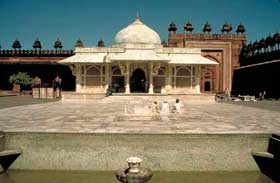 In
the northern part of the courtyard is the superb white marble dargah or
Tomb of Shaikh Salim Chishti, built in 1570. Just as Akbar came to the
saint four centuries ago looking for a son, childless women visit his tomb
today. The carved marble lattice screens (jails) are probably the finest
examples of such work you’ll see anyway in the country.
In
the northern part of the courtyard is the superb white marble dargah or
Tomb of Shaikh Salim Chishti, built in 1570. Just as Akbar came to the
saint four centuries ago looking for a son, childless women visit his tomb
today. The carved marble lattice screens (jails) are probably the finest
examples of such work you’ll see anyway in the country.
The saint’s grandsons, Islam Khan, also has his tomb within
the courtyard. Abul Fazi and Faizi, adviser and poet to Akbar, had their
homes just outside the mosque.
|





